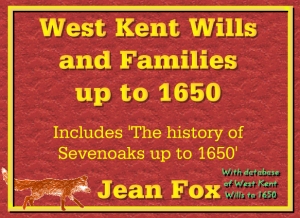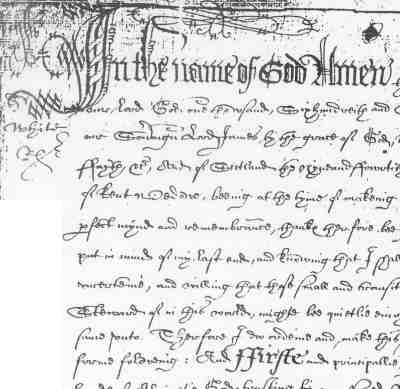West Kent Wills and Families up to 1650
Family life in the sixteenth and early seventeenth centuries
By Jean Fox FBCS, C.Eng.
This 2016 edition replaces the previous CD versions.
Now technology neutral, but no new content.
This reference and history:
|

|
|

|
Accessing the dataOur thanks to Sevenoaks Bookshop for stocking the CDs since 2004. Local history needs local shops that care about it. However the hassle of production compared with the ease of on-line access means we've decided to put it all on-line for free.Follow this link to access the master index of all Sevenoaks and West Kent Wills related books, family trees and data. Or for a quick scan to see if there are names of particular interest to you go here |
|
Family HistoriansCan investigate family connections very quickly when before they would need to visit the appropriate record office or, quite often, offices. The database of 19,000 entries allows searching on ‘sounds-like' and aliases which are two aspects which have been impossible until now. For example "Enge" and "Evans" may be spelt "Inge" and "Yeavens" respectively which might never come to light in a card-file search. |
||
Local historiansLocal historians have practically instant access to data which has never before been collated. It is even possible to find house and field names in these documents by simple searching - that is, if the thousands of items in the various place name indexes don't tell you immediately.
|
||
| Find out how individuals and families lived in the sixteenth and early seventeenth centuries: | ||
|
The wealthy families of Sevenoaks were mainly parish gentry. In the parish of Seal there were four or five wealthy yeoman families continuously adding to their estates whilst some of those in Sevenoaks lost theirs because of their adherence to the Roman Catholic faith. | |
DescriptionThe book describes life in the neighbourhood of the market town of Sevenoaks in West Kent. Prosperity and variety developed due to the position of the town on the Hastings to London Road, the founding of Sevenoaks School and the "Great House of Knole" occupied by the Archbishops of Canterbury from 1456 to 1538 and, later, by the Earls of Dorset.Sevenoaks was home to gentlemen, yeomen, husbandmen, artisans and farmers. Glass-makers, butchers, clothiers and shoemakers, as well as many others, all played their part in the development of the town. Heresy trials, the Reformation and the threat of a Spanish invasion were just three of the outside events which affected the local population. Incidents from the lives of local people show how life was actually lived. These include: the imprisonment of the Roman Catholic gentlemen Samuel Lone; the murder of William Pynden from a local village by men from Sevenoaks; items from the diary of Anne Clifford, wife of the Earl of Dorset; the story of how Leonard Gale used his entrepreneurial skills to become a successful blacksmith; George Scott's investments in the Virginia Company. Other subjects covered in the History (book) include:
Sources used in addition to the surviving wills include:
|
An essential tool for all historiansWithout doubt the History of Sevenoaks to 1650 will become the definitive reference work on the subject of life in the area. Not only is it comprehensively indexed but it can be searched electronically to aid all types of researchers: Family historians, local historians and people looking for ready access to large amounts of ready-transcribed material from the two centuries before 1650.Also included on the disc is an index of 19,000 NW Kent wills. This can be searched by place, name, date and sounds-like. In itself this is a major revolution in the accessibility of these records.
About the authorJean Fox FBCS, C.Eng. retired about 15 years ago after nearly forty years in the computer industry, work which included helping large, well known companies choose, install and operate their computer systems. She has lived in Seal near Sevenoaks for half a century. The History of Sevenoaks is the culmination of 20 years of research into records of the area. One strand of research has been to identify scriptors (professional writers called-in to write wills) by their ‘trade marks' and style which has illuminated seldom considered aspects of the 16th century and uncovered curiosities which need further investigation.
|
|